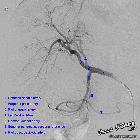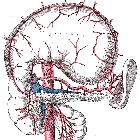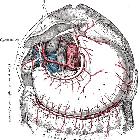gastroduodenal artery




The gastroduodenal artery (GDA) is a terminal branch of the common hepatic artery which mainly supplies the pylorus of the stomach, proximal duodenum, and the head of the pancreas. Due to its proximity to the posterior wall of the first part of the duodenum, the gastroduodenal artery is one of the most important sources of upper gastrointestinal bleeding - mostly secondary to peptic ulcer disease or erosive malignant ulcers.
Gross anatomy
The gastroduodenal artery is a terminal branch of the common hepatic artery along with the proper hepatic artery.
It passes inferiorly behind the first part of the duodenum to the left of the common bile duct where it gives off the supraduodenal artery. More inferiorly it bifurcates into 2 arteries at the upper border of the pancreas:
- right gastroepiploic artery
- runs forward between the pancreas and first part of the duodenum, and passes left into the greater omentum at the head of the pancreas, and runs along the greater curvature of the stomach to anastomose with the left gastroepiploic artery (from the splenic artery)
- superior pancreaticoduodenal artery
- divides into anterior and posterior branches which encircle the pancreatic head and anastomoses with similar branches of the inferior pancreaticoduodenal artery from the superior mesenteric artery
Variant anatomy
The transverse pancreatic artery may arise from the GDA rather than the splenic artery.
A single or double cystic artery may arise from the GDA.
Siehe auch:
- Arteria hepatica communis
- Pseudoaneurysma der Arteria gastroduodenalis
- Arteria pancreaticoduodenalis superior
- Arteria gastroomentalis dextra
und weiter:

 Assoziationen und Differentialdiagnosen zu Arteria gastroduodenalis:
Assoziationen und Differentialdiagnosen zu Arteria gastroduodenalis: